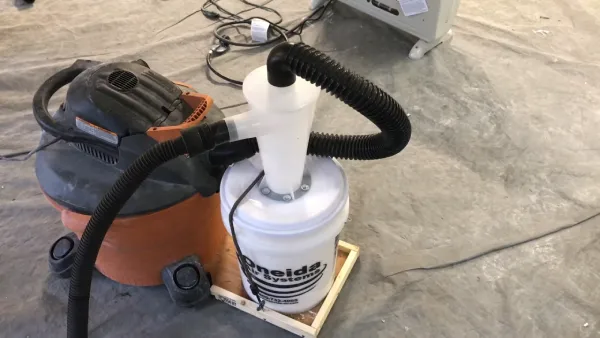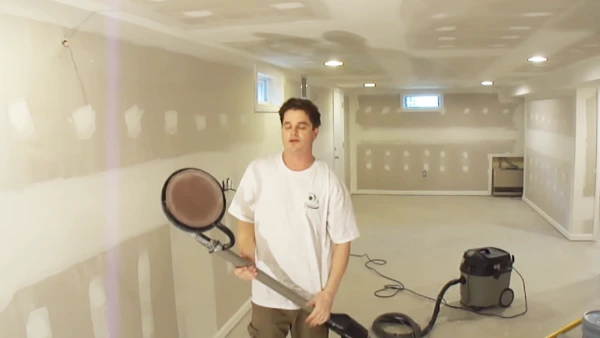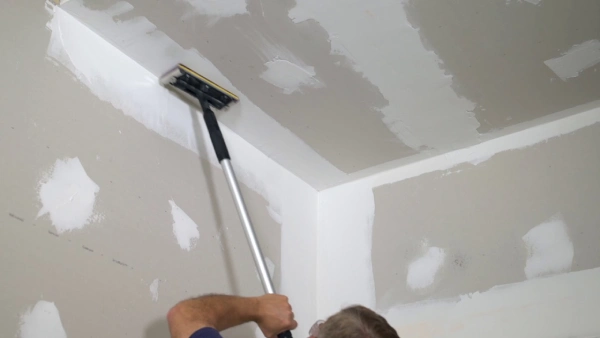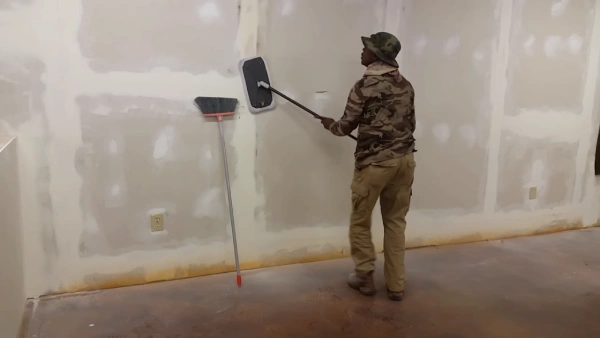Last Updated on January 21, 2023
Worried about the health implications of pesky drywall dust in your home or workplace? Wondering if you can suck it up with a vacuum to keep yourself and those around you safe?
Vacuuming with a shop vac with a HEPA filter is the best way to quickly suck up debris without missing any hazardous particles. This powerful filtration will capture even the tiniest particles so they don’t make it back into the air and cause potential harm.
Make sure you stay away from using the regular household vacuum. The wrong suction power can actually do more harm than good and leave surfaces worse off. Let’s take some time here to go over how best to clean up this potentially hazardous material in an effective way.
Can You Vacuum Drywall Dust: What Kind?

Shop vacs with HEPA filters are a great option for capturing and trapping dust particles down to 0.3 microns in size at a rate of 99.97 percent efficiency. Some wet/dry vacs with 3-layer fine dust materials filters are designed specifically for capturing even tiny particles in a given area.
Many wet/dry vacs come in both corded and cordless models, allowing you to choose one that suits your needs best, depending on the job at hand.
Additionally, some vacuums have extra features such as variable suction control and adjustable nozzle heads, making them ideal for cleaning up after renovations involving drywall.
What are the Best Methods to Vacuum Drywall Dust?

When cleaning up drywall dust, two popular methods are often suggested: using a shop vac and controlling the dust when sanding. Both are effective ways to keep the air clean of the small particles that create messes and can be harmful to your health if inhaled.
Method 1: With a Shop Vac:
Cleaning up drywall dust is an inconvenient and time consuming task, but it is essential to ensure a healthy home environment. The only way to get rid of maximum drywall dust is through thorough cleaning sessions, which requires a Shop Vac.
Step 1: Sweeping the Floor and Ceiling:
Start to sweep the floors with a broom or vacuum extension. On concrete or tile floors, you should use a bristle-style broom to capture any large pieces or chunks of drywall sheetrock dust.
On wood floors, use a soft-bristle broom to avoid damaging the finish. For extra protection on wood surfaces, cover them with a damp microfiber cloth before sweeping.
In addition, be sure to check window sills, door frames, and ceilings for any thin layers of dust that may have traveled through the air. After sweeping floors and ceilings, you should wipe them down with a damp cloth for extra removal of fine particles and dirt buildup.
Step 2: Vacuuming the Room with a Shop Vac:
Once you have swept the floor, use a shop vac or vacuum cleaner with an extendable hose attachment to capture any remaining dust and debris from hard-to-reach spots such as doorways and windowsills.
Ensure that you’re using the correct attachments for each surface type, so you don’t damage them while vacuuming. For example, if you are vacuuming hardwood floors, use an upholstery brush attachment instead of an industrial brush attachment.
Step 3: Wet Cleaning with a Damp Cloth:
To further remove stubborn particles from carpets and other fabrics in your home, wet clean your surfaces using a damp cloth or mop head. This will help break up any remaining dirt and debris so that it can be effectively sucked up by your shop vac or vacuum cleaner in step 4.
You’ll need to pay close attention when wet cleaning delicate fabrics such as velvet or leather as too much moisture could potentially damage these materials over time.
Step 4: Re-vacuum:
After wet cleaning your carpets and furnishings with a damp cloth, re-vacuum all surfaces once again to remove any residual dirt left behind by the wet cleaning process.
Be sure to change out your filter every few passes as this will help ensure maximum suction power while removing all remaining drywall dust from your home interior.
Step 5: Clean With Microfiber Cloth:
Once you have finished vacuuming your home interior for all remaining drywall dust, give all surfaces one final wipe down using a damp microfiber cloth for best results.
Microfiber is perfect for removing stubborn particles off delicate surfaces such as glass or marble countertops without leaving any streaks or smudges behind. This added level of polishing will help keep these areas looking clean longer than if they were simply left untouched after vacuuming alone.
Method 2: Dust Control When Sanding
Dust control when sanding drywall is an important part of keeping the work area clean and safe. Proper dust control measures are essential to protect yourself from dangerous particles that can be inhaled and also to keep the work area neat and tidy.
Step 1. Setting Up Entryways:
When sanding drywall, it’s important to set up an entryway so that dust doesn’t spread throughout your workspace. Cover the door frames leading into the workspace, as well as windows and other openings where outside air could get in with drop cloths or plastic sheeting.
Make sure to seal all seams with duct tape and secure them in place so no dust is able to escape.
Step 2. Keep Work Areas Locked:
Keep your workspace secure! It’s essential to lock work areas while sanding or carrying out any other tasks that create dust. It helps contain the particles, and it keeps everyone safe by preventing them from coming into contact with the hazardous material.
Step 3. Vacuum and Dampen the Floor During Breaks:
When taking breaks from sanding or working on other tasks that create large amounts of dust, take a few minutes to vacuum and dampen the floor with water or a wet dry vacuum cleaner.
Then you can continue working on your project without worrying about any debris left behind. Once you have finished cleaning up the drywall dust using your shop vac with a HEPA filter attached, make sure to get rid of it in the right way.
How Do You Clean Drywall Dust Without a Shop Vac?

Cleaning up drywall dust can be a daunting task, as it is easily airborne and very fine in texture if you don’t own a shop vac. Put that water to work and get your space back in tip-top shape.
Step 1: Gather Protective Gear and Materials:
It’s essential to have the right protective gear when cleaning drywall dust.
A) Protective Gear Needed:
1. Safety glasses
2. Respirator mask
3. Work gloves
B) Materials Required for Clean-up
1. Bucket of warm water
2. Sponge or soft cloths
3. Clean, dry rags or towels
Step 2: Prepare the Area:
Remove all furniture, rugs, drapes, and other items from the space you’re cleaning before cleaning drywall dust.
To keep any mess contained during the process, cover the floor with plastic sheeting or drop cloths. Also, take off the screens on the doors and windows before you start so that drywall dust won’t get stuck there.
Step 3: Secure the Area:
Secure any items that might be disturbed during cleanings such as bookshelves or picture frames, by placing them near walls or in corners away from where cleaning will take place. This helps avoid unnecessary accidents while ensuring those items are not damaged during the cleanup process either.
Step 4: Sweep the Area to Remove Loose Debris:
Start by sweeping up any loose particles on the walls and ceiling with a broom. Make sure you pay special attention to window frames, doorways, and ledges, as this is where most of the dust will settle after installation.
Sweep away the remaining remnants of construction and ensure your space is pristine. Loose screws, nails, or other debris can be easily tidied up to keep your area clear of any unwanted hazards.
Step 5: Mopping Up Drywall Dust With Water & Soft Clothes/Sponges:
Once all visible dust has been removed, it’s time to mop up any remaining residue using warm water mixed with dish detergent if needed for heavy set-in dirt spots.
Using a scrubbing brush and sponges or cloths dampened in a warm water solution, scrub all surfaces, even crevices like corners of walls until all traces of dirt are gone.
Don’t forget to rinse wet mops often to avoid spreading dirt around instead of removing it from cleaned surfaces. Dry surfaces off using clean towels afterward, ensuring no residual moisture is left behind that can cause stains later on.
Will Drywall Dust Ruin a Vacuum?

When it comes to vacuums, drywall dust can be quite damaging if not properly handled. The tiny particles can easily find their way into the motor and cause corrosion or short-circuit damage to important components.
This debris can also clog vacuum filters and hoses, leading to reduced suction power or even a complete breakdown of the machine. It is best to use specialized HEPA filtration systems on vacuums when working in areas with high levels of drywall dust.
How Do You Ventilate a Room for Drywall Dust?
The best way to ventilate a room to remove drywall dust is to use fans. Fans can draw the dust out of the room and provide an avenue for fresh air to enter in order to circulate air effectively and minimize dust accumulation.
Depending on the size of the room and other factors, you may want to use multiple fans in order to get adequate ventilation and quickly clear out any extra debris or dirt while also controlling humidity levels.
It can be beneficial to place fans strategically throughout the area, whether it’s near windows, doorways or other access points as well as close to where you’re cutting drywall. Using an exhaust fan is also recommended to get rid of any existing particles before starting sanding and sawing.
Does Drywall Dust Come Out of the Lungs?
Yes, drywall dust can come out of the lungs if inhaled deeply enough into the respiratory system. When drywall dust gets inhaled, it can get trapped deep inside the bronchial tubes and alveoli, accumulating over time, leading to asthma and lung cancer.
Can Drywall Dust Ruin My Furnace?

Drywall dust can absolutely ruin your furnace if it gets sucked into its systems. Blower motors, heat exchangers, cooling coils, and ductwork are all susceptible to clogging from very small particles like drywall dust.
With time, these parts will become caked with debris, which can damage the parts, limit airflow through ducts, or prevent proper heat transfer.
How Long Does It Take Drywall Dust To Settle?
After a construction project involving walls with mainly gypsum-based materials, the airborne particles caused by sanding will usually settle within 24 to 48 hours.
Though larger chunks should have settled low enough that they don’t affect living spaces nearby, very fine particulates may still linger on carpets and other surfaces.
Eliminate Pesky Drywall Dust with a HEPA Shop Vac
Vacuuming drywall dust is one of the most effective ways to remove this pesky material from your home. A HEPA shop vac is an effective way of getting rid of those pesky particles without making more mess elsewhere.
This method allows you to quickly remove large amounts of particles without worrying about missing some smaller ones that could potentially be dangerous if breathed in.
Other effective methods like using damp cloths or sponges or simply sweeping away with a broom and pan, can also be utilized as needed depending on the situation at hand.
With proper knowledge and technique, you can easily make sure any unwanted drywall dust has been properly cleaned away from your living space so that your family can stay healthy and safe.



